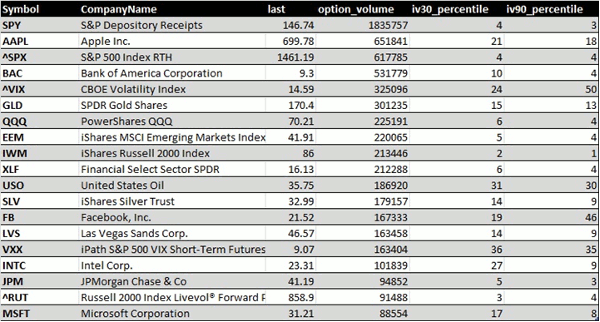Jared Woodard of Condor Options explains the recent declines in implied volatility, and therefore option prices.
The question we’re all hearing a lot these days is, are you better off now than you were four years ago? What about one year ago?
If you’re like most traders, looking at it from a market perspective, your market sentiment has probably improved substantially.
There are plenty of ways to measure trader sentiment—we could look simply at the run-up in stock prices, or use a more sophisticated metric like the level of implied correlation. In between those two estimates, we might also look at the implied volatility of stock options, measured as a percentage of their trailing one year range.
If you look at the stocks, indexes, and ETFs with the most active options on Monday, one fact that stands out is how inexpensive options are at both one- and three-month horizons. Some of these assets are trading at implied volatility levels that are at or near 52-week lows, like iShares Russell 2000 Index (IWM), JP Morgan (JPM), and iShares MSCI Emerging Markets Index (EEM).
The explanation for these cheaply priced options is that the trailing volatility of the underlying assets has declined just as sharply. It’s not just that stocks have rallied hard since July, but that they have done so with almost no meaningful pauses.
It’s not just the most active options that are pushing toward their lowest levels, either. Of the 280 stocks that traded more than 5,000 contracts on Monday, the median percentile rank of one-month implied volatility was just 16%.
Conversely, the few assets on this top-20 list with higher implied volatilities either have plausible issue-specific factors justifying the higher bid—like United States Oil Fund (USO) and Facebook (FB)—or, like iPath S&P 500 VIX Short Term Futures ETN (VXX) and CBOE Volatility Index (VIX), are high precisely because volatility levels have been falling so sharply.
Conservative traders and investors should be taking advantage of these low levels of implied volatility to rebalance portfolio hedges and to lock in gains on stock positions by replacing shares with inexpensive calls. Using calls as stock replacements will allow you to participate in further upside while limiting your downside risk, and relatively cheap option prices mean you’re less likely to be overpaying for premium here.
Active traders should be tilting exposure more in favor of option buying. There are still some pockets of sellable premium out there, but in this context it makes sense to be more selective than usual.
Jared Woodard is the principal of Condor Options. With over a decade of experience trading options, equities, and futures, he publishes the Condor Options newsletter (iron condors) and associated blog. Disclosure: There are positions open in IWM and USO in the newsletter.



















